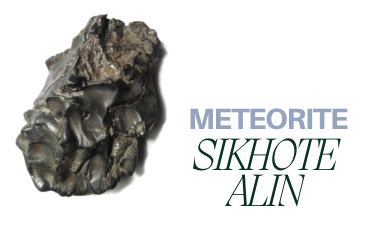Sikhote Alin Meteorite | Information, History, Properties All Entries

The Sikhote-Alin meteorite is a remarkable and historic cosmic visitor that crashed to Earth on February 12, 1947, in the Sikhote-Alin Mountains of eastern Russia. This meteorite fall is one of the largest witnessed meteorite events in recorded history, leaving an indelible mark on both scientific knowledge and the field of meteoritics.
Composed primarily of iron-nickel, the Sikhote-Alin meteorite is classified as an iron meteorite. It exhibits a characteristic shape known as a "thumbprint regmaglypt," which is formed as the meteorite experiences intense heating and sculpting during its descent through the Earth's atmosphere. These regmaglypts, or thumbprint-like depressions, are a distinctive feature of Sikhote-Alin specimens.
The Sikhote-Alin meteorite fall was a breathtaking spectacle. Witnesses reported seeing a dazzling fireball streak across the sky, followed by a series of loud explosions and sonic booms that echoed through the region. The impact of the meteorite shower was so powerful that it caused ground tremors and initiated forest fires over an extensive area.
Since the Sikhote-Alin meteorite fall occurred in a sparsely populated region, the recovery of numerous fragments was possible. Over 23 tons of meteoritic material have been collected from the site, making it one of the largest meteorite showers ever recorded. The fragments range in size from tiny shards to massive specimens weighing several kilograms, and they bear the characteristic features of iron meteorites, such as the pronounced Widmanstätten pattern.
The Sikhote-Alin meteorite fall has been of immense scientific importance. It has provided researchers with a wealth of material to study and analyze, offering insights into the composition, structure, and formation of iron meteorites. Scientists have utilized various techniques, including chemical analysis and microscopic examination, to unravel the mysteries held within these extraterrestrial fragments.
Furthermore, the Sikhote-Alin meteorite has played a significant role in advancing our understanding of meteorite dynamics and atmospheric entry processes. The study of its regmaglypts and other features has contributed to our knowledge of the intense heat and pressure experienced by meteorites during their high-speed descent through the Earth's atmosphere.
The Sikhote-Alin meteorite has also captured the fascination of collectors and enthusiasts. Its distinct appearance, historical significance, and limited availability have made Sikhote-Alin specimens highly sought after in the meteorite market. These specimens are admired for their unique and captivating aesthetic qualities, which showcase the natural sculpting and rugged beauty borne from their cosmic journey.
In conclusion, the Sikhote-Alin meteorite fall of 1947 stands as a testament to the awe-inspiring nature of meteoritic events. Its impact on scientific research, coupled with its visual allure, has solidified its place in both scientific and collector communities. The Sikhote-Alin meteorite continues to provide valuable insights into the mysteries of our universe, reminding us of the profound connections between Earth and the cosmos.



